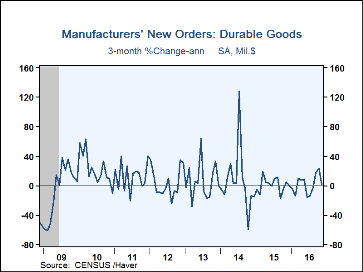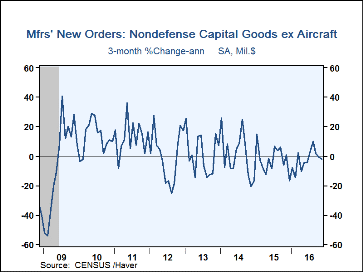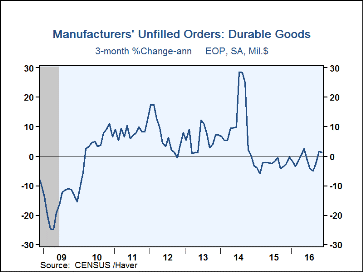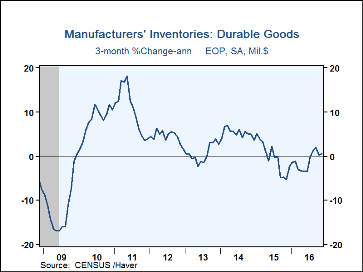 Global| Dec 22 2016
Global| Dec 22 2016Durable Goods Orders Recoil in November--But All Aircraft
by:Sandy Batten
|in:Economy in Brief
Summary
Led by a 13.2% drop in orders for transportation equipment (after a 12.3% m/m surge in October), U.S. durable goods orders recoiled in November, retreating 4.6% m/m (-1.9%y/y) following an upwardly revised 4.8% m/m jump in October. [...]
Led by a 13.2% drop in orders for transportation equipment (after a 12.3% m/m surge in October), U.S. durable goods orders recoiled in November, retreating 4.6% m/m (-1.9%y/y) following an upwardly revised 4.8% m/m jump in October. The Action Economics Forecast Survey had looked for a 4.2% m/m decline. The decline in transportation orders was due completely to a 74% collapse in nondefense (civilian) aircraft orders, payback for their outsized 95% explosion in October. Excluding transportation, other orders rose 0.5% m/m (1.8% y/y) in November on top of a 0.9% m/m increase in October. This was the second consecutive month that orders excluding transportation were higher than a year ago. Before this, ex-transportation orders had fallen year-over-year in each month since December 2014. Excluding defense and aircraft, orders increased 0.6% m/m (1.2% y/y). While the November rise was modest, it was the sixth consecutive monthly increase, the longest string of monthly increases for this key private-sector indicator since the first months of the recovery in 2009
Core capital goods orders (nondefense capital goods orders excluding aircraft) rose a healthy 0.9% (-3.2% y/y) in November. After falling consistently during 2015 and early 2016, these orders appear to be exhibiting a modest revival lately, with increases in five of the past six months. Business investment spending has been weak in the national accounts for the entire expansion. Hopefully, the recent behavior of capital goods orders points to a pending pickup. Core capital goods shipments, an accurate gauge of the near-term course for business fixed investment spending, edged up 0.2% m/m in November (-4.0% y/y). Core capital goods shipments in October and November were 1.3% AR above the third quarter average, pointing to a modest revival in business fixed investment in 4Q--this measure has declined in each of the preceding four quarters
Total shipments edged up 0.1% m/m (-0.8% y/y) in November following a 0.1% m/m decline in October. Unfilled orders slipped 0.2% m/m (-1.2% y/y) after having risen 0.8% m/m in October. And inventories of durable goods nudged up 0.1% m/m (-0.8% y/y) in November after having been unchanged in both September and October.
The durable goods figures are available in Haver's USECON database. The Action Economics consensus forecast figure is in the AS1REPNA database.
| Durable Goods NAICS Classification | Nov | Oct | Sep | Nov Y/Y | 2015 | 2014 | 2013 |
|---|---|---|---|---|---|---|---|
| New Orders (SA, %) | -4.6 | 4.8 | 0.3 | -1.9 | -2.9 | 4.8 | 2.8 |
| Transportation | -13.2 | 12.3 | 0.7 | -8.3 | -4.0 | 6.8 | 8.8 |
| Total Excluding Transportation | 0.5 | 0.9 | 0.1 | 1.8 | -2.3 | 3.8 | -0.1 |
| Nondefense Capital Goods | -19.5 | 14.4 | 3.9 | -11.7 | -9.6 | 1.2 | 4.2 |
| Excluding Aircraft | 0.9 | 0.2 | -1.5 | -3.2 | -3.2 | 0.8 | 0.4 |
| Shipments | 0.1 | -0.1 | 0.8 | -0.8 | 1.1 | 3.5 | 2.8 |
| Unfilled Orders | -0.2 | 0.8 | 0.2 | -1.2 | -2.4 | 8.6 | 5.7 |
| Inventories | 0.1 | 0.0 | 0.0 | -0.8 | -0.6 | 5.2 | 1.0 |
Sandy Batten
AuthorMore in Author Profile »Sandy Batten has more than 30 years of experience analyzing industrial economies and financial markets and a wide range of experience across the financial services sector, government, and academia. Before joining Haver Analytics, Sandy was a Vice President and Senior Economist at Citibank; Senior Credit Market Analyst at CDC Investment Management, Managing Director at Bear Stearns, and Executive Director at JPMorgan. In 2008, Sandy was named the most accurate US forecaster by the National Association for Business Economics. He is a member of the New York Forecasters Club, NABE, and the American Economic Association. Prior to his time in the financial services sector, Sandy was a Research Officer at the Federal Reserve Bank of St. Louis, Senior Staff Economist on the President’s Council of Economic Advisors, Deputy Assistant Secretary for Economic Policy at the US Treasury, and Economist at the International Monetary Fund. Sandy has taught economics at St. Louis University, Denison University, and Muskingun College. He has published numerous peer-reviewed articles in a wide range of academic publications. He has a B.A. in economics from the University of Richmond and a M.A. and Ph.D. in economics from The Ohio State University.










